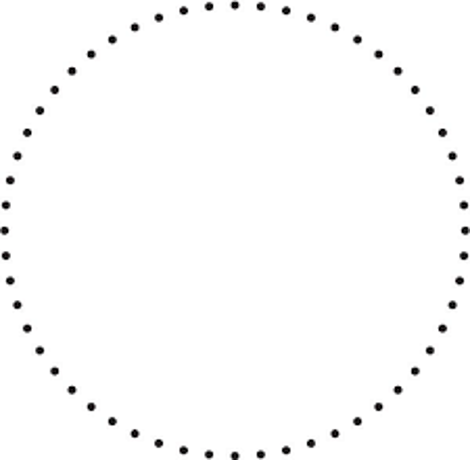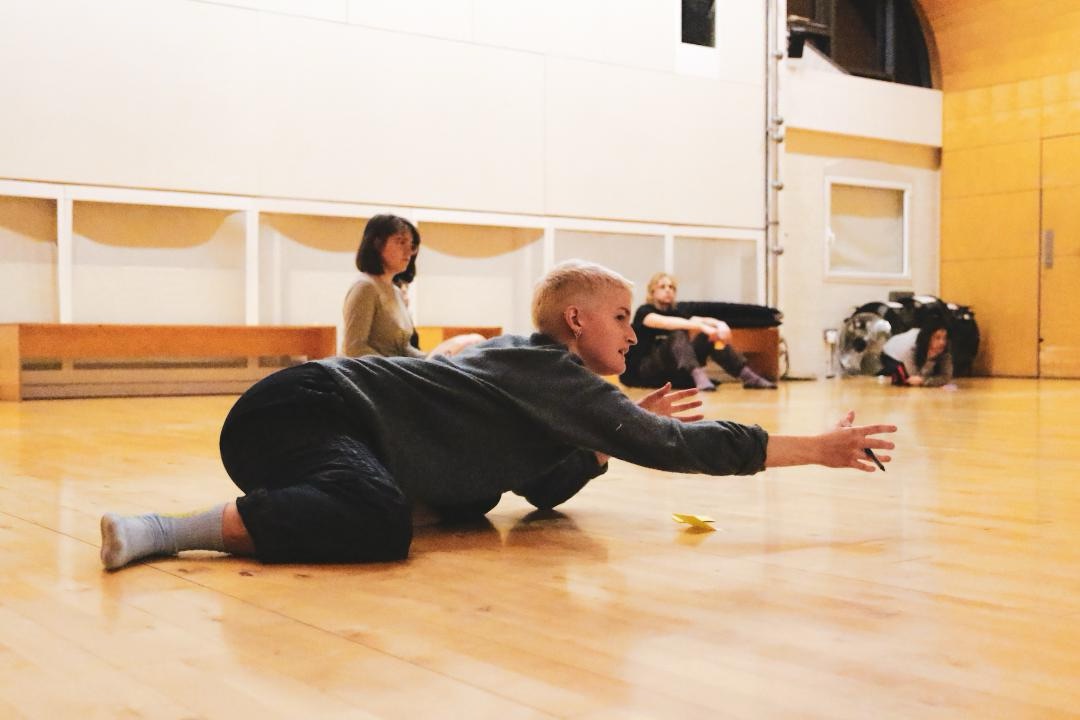Words by Stella Rousham
The Roof Studio at Siobhan Davies Studios has and always will be a kind of sanctuary. Arriving at 18:00 sharp to watch the Next Choreography rehearsal, I was immediately transported from the chaos of London public transport – delays, red signals, cancellations – to a warming, welcoming and immersive hub of creative activity.
Clap-clap, both arms strike above the head like an arrow. Gently, pull left hand along right arm, lean back and bend knees.
“Can we do that again?”
Clap-clap, both arms strike above the head like an arrow. Gently, pull left hand along right arm, lean back and bend knees.
“Yeah, nice, that’s great”
Sitting in a large circle of 20, we (the Next Choreography cohort, two course leaders, Nancy May Roberts & Annie Pui Lok and myself), moved through each piece based on where in the SDS building it will take place – Entrance, Ground Floor, Changing Rooms and Roof Studio.
As a witness to the ‘work in progress’ sharing, I was inspired and wonderfully surprised at the endless possibilities of choreography put forward by this year’s cohort. This includes (but is not limited to): a durational work exploring embodied encounters with people and places (VILLAGERS by Rachel Coleman), a short film documenting the cracks between life and dance (Warm-Ups by Ray Sims), a quartet examining living with dyspraxia and ample opportunities for audience participation.

In this written reflection, I hope to capture an essence of the rehearsal, offering a snapshot of just some of the myriad of works that will be presented at the Next Choreography Festival on Saturday 23rd March.
ENTRANCE
Two dancers wearing raincoats stand with several meters between them, their gaze fixed intensely on one another. Ever-so discretely, in perfect synchronicity, each hesitantly lifts their lower left arm, fingers straining like they are clasping something. ZIIIIPPPP. A sudden pulling and each rips open the zip on their raincoats. Bumph. Raincoats are pealed off and dropped with a breath of air to the floor.
Through a careful combination of pedestrian movement and precise timing, City Life by Lin Ji and Billy Gigurtsis offers a playful challenge to audience expectations and feelings of comfort. Located at the entrance of the SDS building, the duet offers an intriguing parallelism between the performers and the habitual, unconscious movements of audience members as they arrive (who may also be removing their outside jackets). Through subtle mirroring, this duet examines how and why everyday movements can be so confronting when ‘performed’ out of context.
GROUND FLOOR
A thin red rope is weaved delicately between the finger-tips of a solo dancer; the childhood game of ‘Cats Cradle’. Middle right finger weaves into the left hand, pulling the thread out and up to the right. Middle left finger weaves into the right hand, pulling the thread out and up to the left. Limbs begin to tangle as feet replace hands, toes take the place of fingers. The red rope is tightened and taut, stretching in at an angle, between a leg lunging and knee bending to the left. The dancer becomes a needle between thread. Behind the dancer, a projected slideshow of black-and-white photographs: telephone wires….suburban houses…rooftops. – Description of Zhuyan Hu’s ‘The Devil’s Grin’
Crumple, crumple, crack. A single performer coils on the floor through foetal position beneath an A2 piece of white paper. As the performer curves and flexes their spine, I catch glimpses of drawings sketched on the paper in the brown ink. The performer grows to standing. With the paper hanging over their head and side body, only their lower torso and legs are visible – weaving, turning and twisting across the floor. – Description of Tasalla Tabaom’s solo
The ground floor promises several works, including solos by Tasalla Tabasom and Zhuoyan Hu, connected through ideas of the body, home, power and identity. In both, the thoughtful and nuanced use of props offer a blurring of the subject/object boundary, raising important questions around manipulation and control. As these solos continue to be rehearsed and reach a ‘resolution’, it would be effective to consider the placement of the audience and whether the props could also extend to them.
CHANGING ROOMS
How does a space hold the duality of exile and safety?
This is one of the questions explored through a site-specific piece offered by Aisha Kacie, set to take place in the changing rooms. Making use of the abundance of sensory tools in this space: water, cubicles and yes, even lockers, the performers hope to transport audiences into a realm of liminality. Within the highly intimate and gendered space of the changing rooms, I am particularly excited at how lighting and darkness will be used to investigate the dynamics between visibility/invisibility, performance/non-performance and stimulation/non-stimulation.
ROOF STUDIO
In the final destination, the Roof Studio hosts a handful of pieces that encapsulate the over-arching sentiment of Next Choreography – enabling individuals to articulate their distinct artistic voice within a symbiotic collective.
Right leg, left leg, right leg, left leg, right leg, left leg
Round, round, round, round, round, round, round
Breathe in, breathe out, breathe in, breathe out, breathe in, breathe out
Feet pound, arms swing, feet pound, arms swing, feet pound, arms swing
With an invitation for audience members to join in, Martha Harlan’s You and I are Here seeks to move continuously over the course of 30 minutes, pausing only when intercepted by snippets of pre-choreographed solos. Examining the limits of repetition, rest and exhaustion, this durational work asks how we can build care through extremity. For Martha, a consideration is how to empower audience members to partake, holding the potential apprehension or confusion.
Similarly, Kardelen Yildirim’s solo strives to embody contradictions, honouring revolution as an internal and external phenomena. Accompanied by the delicate melodies of traditional Kurdish instruments (Tembûr and Tonnak), Kardelen’s rapid turns, elastic kicks, swishes and lunges, capture the waves of the Kurdish Feminist Movement (Jineolojî) on micro and macro scale.
Unable to work with children directly, on the middle floor, Mark Crawley has devised a solo that invites an imaginative and resourceful exploration into childhood and young-ness. Through a nimble assortment of spins, stamps, arabesques and tumbles, Mark is attentive to the thrills and discomfort of embodying ‘childness’ in an adult body. I am left asking: can the hope and potential of ‘youngness’ become a limitation and constraint?
In a beautifully bitter-sweet choreography, Patër by Anna Nicholls seeks to grapple with grief of losing her Dad, inspired by tracks found in his record collection. Launching across the room through a powerful array of barrel turns, kick flicks and rolls, Anna captures the ambivalence of loss as a simultaneously isolating and collective experience. I am keen to see how this solo builds into what promises to be a deeply moving group choreography, reflecting what she calls ‘the army of people’ around her.
Observing the Next Choreography rehearsal last week, I am particularly struck by the caring community of practice this group of young artists have choreographed. From participants welcoming me the moment I arrived, noticing that I was sitting nervously at the side, to others openly sharing choreography exploring personal difficulties of grief, to the endless exchanges of smiles, post-it notes of feedback and reassuring pats on back. In their own words, the Next Choreography cohort have co-created a distinctly ‘non-hierarchal’ and ‘non-capitalist’ space that enables vulnerability and exposure with the promise of care, nurture and growth.
This article was commissioned by SDS.
